Comprehensive Analysis of Quality and Risk Management in Healthcare
VerifiedAdded on 2020/06/04
|6
|1507
|489
Report
AI Summary
This report delves into the critical aspects of quality and risk management within the healthcare sector, using Wellington Hospital as a case study. It examines the significance of quality nursing care, outlining key criteria such as ethical behavior, consumer rights, stewardship, and patient-centered care. The report discusses the qualitative measures employed to improve services, including the use of surveys and interviews to capture patient experiences, while also acknowledging factors affecting service quality, such as stakeholder perceptions and regulatory constraints. Furthermore, it details the elements of a comprehensive risk management plan, emphasizing the identification, avoidance, and mitigation of risks to ensure patient safety and operational efficiency. The conclusion highlights the need for continuous improvement in quality of services and proactive risk management strategies within healthcare settings.
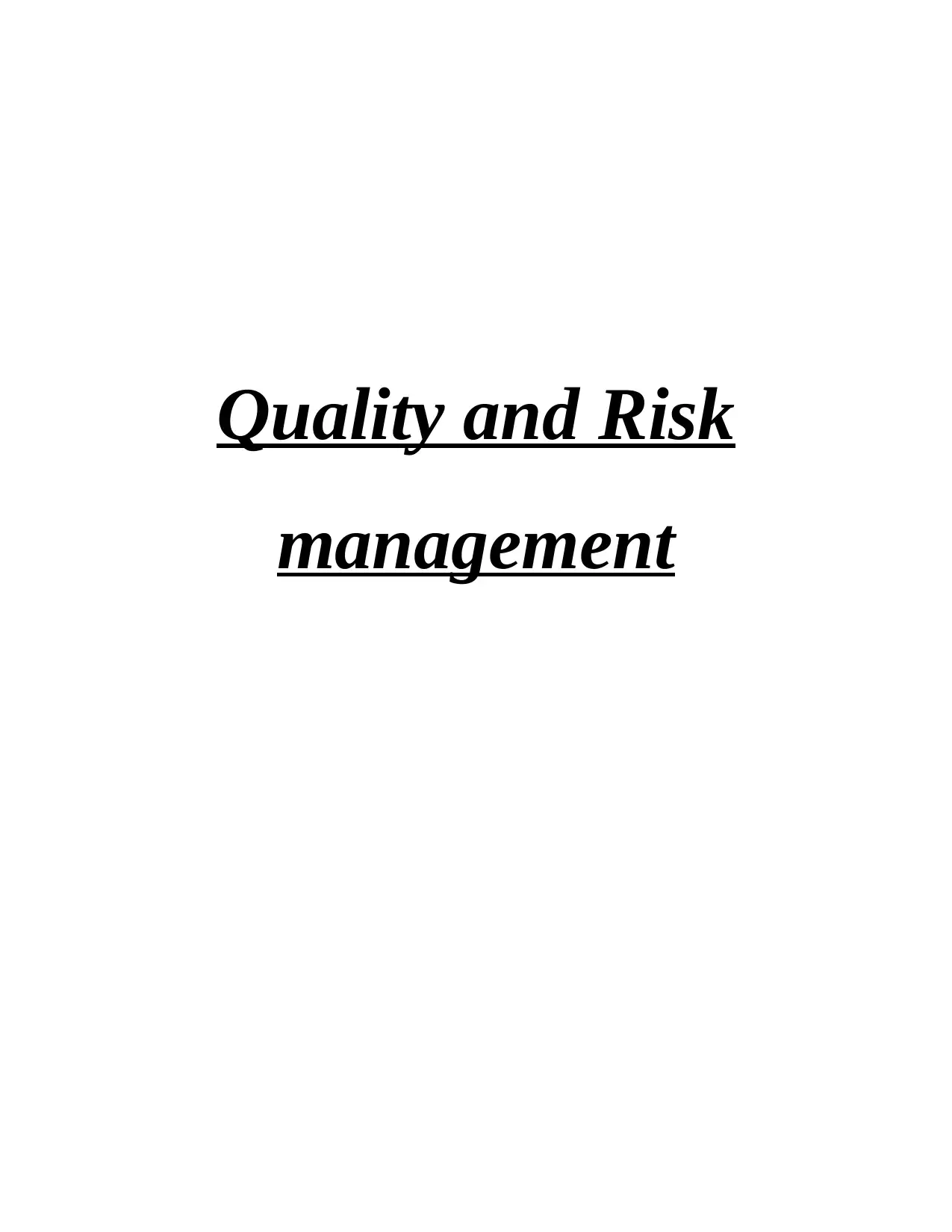
Quality and Risk
management
management
Paraphrase This Document
Need a fresh take? Get an instant paraphrase of this document with our AI Paraphraser
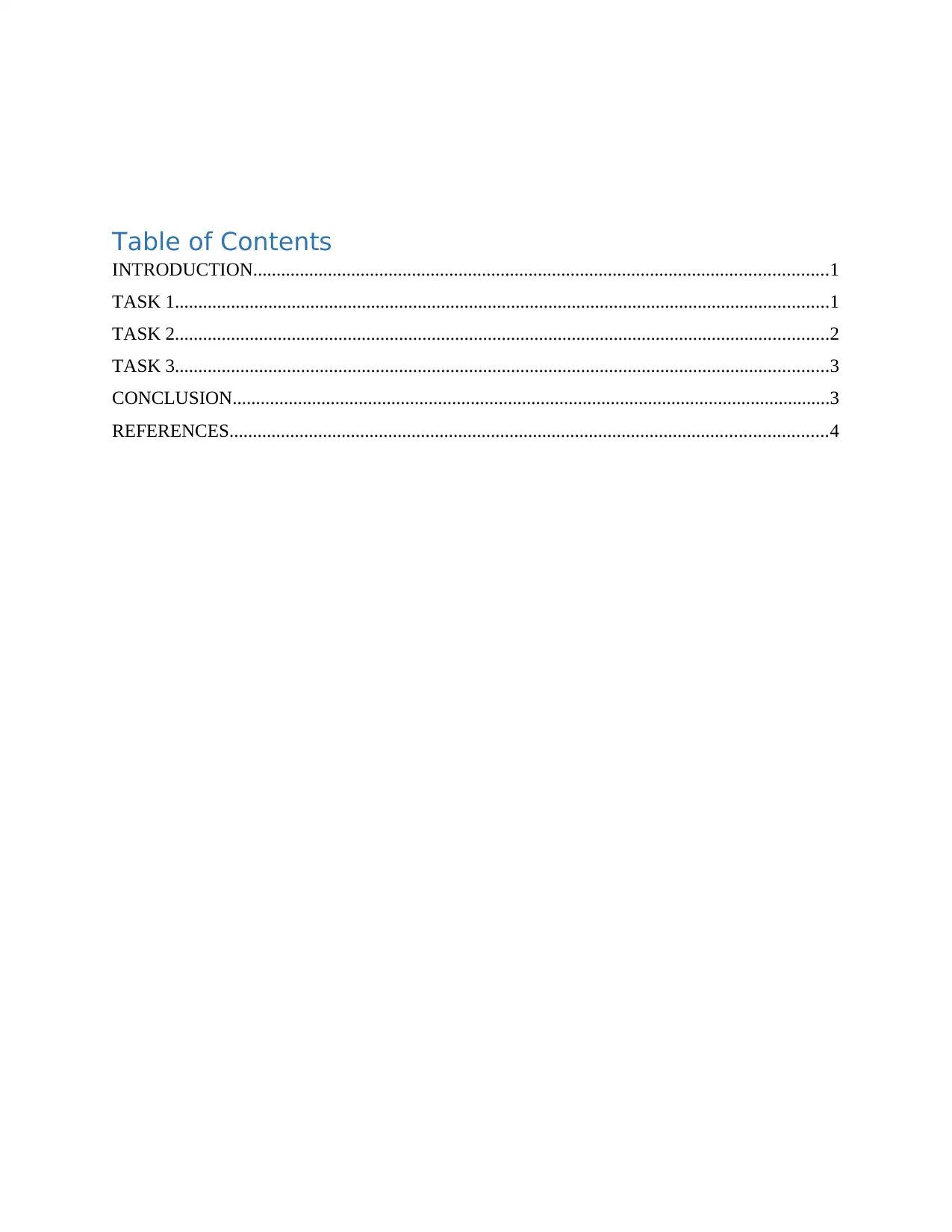
Table of Contents
INTRODUCTION...........................................................................................................................1
TASK 1............................................................................................................................................1
TASK 2............................................................................................................................................2
TASK 3............................................................................................................................................3
CONCLUSION................................................................................................................................3
REFERENCES................................................................................................................................4
INTRODUCTION...........................................................................................................................1
TASK 1............................................................................................................................................1
TASK 2............................................................................................................................................2
TASK 3............................................................................................................................................3
CONCLUSION................................................................................................................................3
REFERENCES................................................................................................................................4
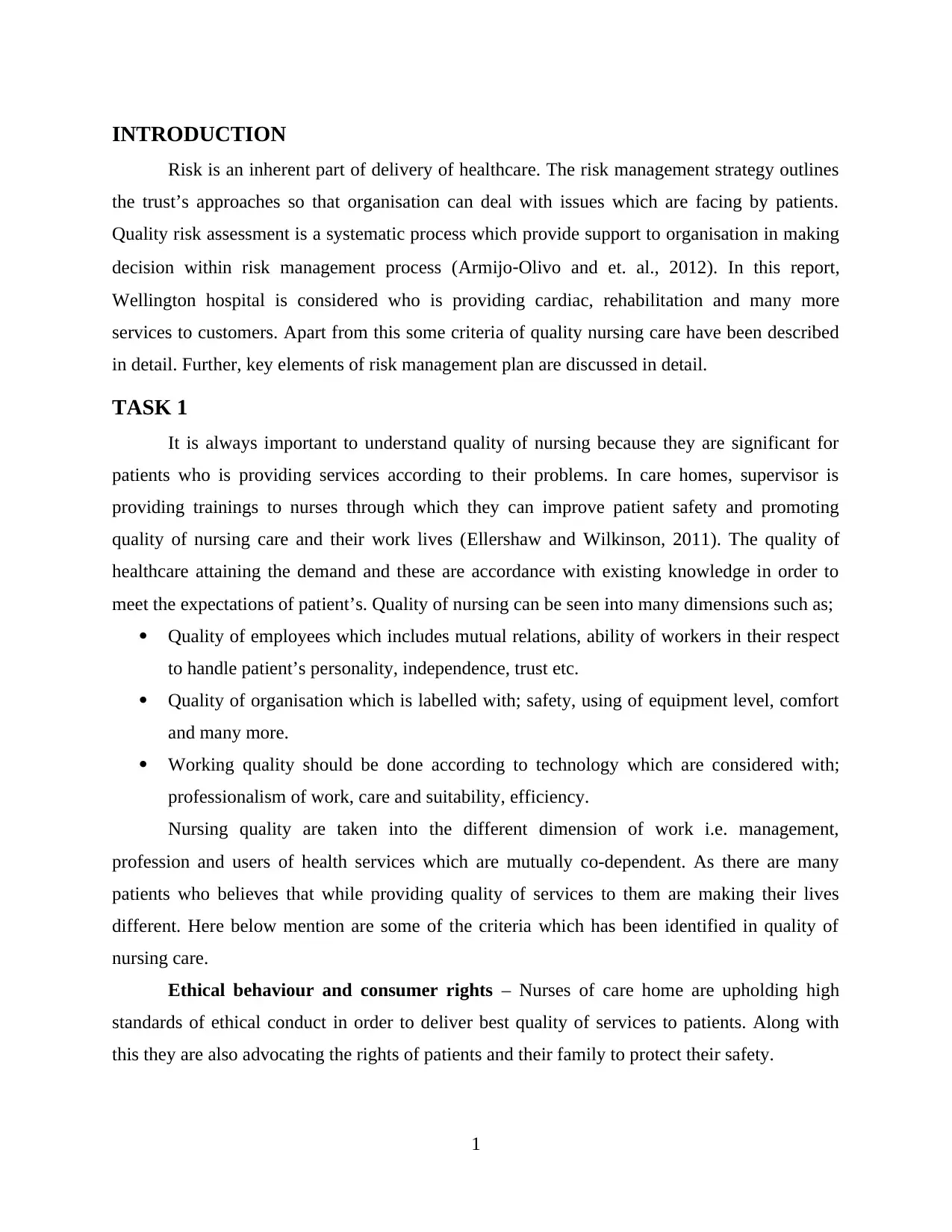
INTRODUCTION
Risk is an inherent part of delivery of healthcare. The risk management strategy outlines
the trust’s approaches so that organisation can deal with issues which are facing by patients.
Quality risk assessment is a systematic process which provide support to organisation in making
decision within risk management process (Armijo‐Olivo and et. al., 2012). In this report,
Wellington hospital is considered who is providing cardiac, rehabilitation and many more
services to customers. Apart from this some criteria of quality nursing care have been described
in detail. Further, key elements of risk management plan are discussed in detail.
TASK 1
It is always important to understand quality of nursing because they are significant for
patients who is providing services according to their problems. In care homes, supervisor is
providing trainings to nurses through which they can improve patient safety and promoting
quality of nursing care and their work lives (Ellershaw and Wilkinson, 2011). The quality of
healthcare attaining the demand and these are accordance with existing knowledge in order to
meet the expectations of patient’s. Quality of nursing can be seen into many dimensions such as;
Quality of employees which includes mutual relations, ability of workers in their respect
to handle patient’s personality, independence, trust etc.
Quality of organisation which is labelled with; safety, using of equipment level, comfort
and many more.
Working quality should be done according to technology which are considered with;
professionalism of work, care and suitability, efficiency.
Nursing quality are taken into the different dimension of work i.e. management,
profession and users of health services which are mutually co-dependent. As there are many
patients who believes that while providing quality of services to them are making their lives
different. Here below mention are some of the criteria which has been identified in quality of
nursing care.
Ethical behaviour and consumer rights – Nurses of care home are upholding high
standards of ethical conduct in order to deliver best quality of services to patients. Along with
this they are also advocating the rights of patients and their family to protect their safety.
1
Risk is an inherent part of delivery of healthcare. The risk management strategy outlines
the trust’s approaches so that organisation can deal with issues which are facing by patients.
Quality risk assessment is a systematic process which provide support to organisation in making
decision within risk management process (Armijo‐Olivo and et. al., 2012). In this report,
Wellington hospital is considered who is providing cardiac, rehabilitation and many more
services to customers. Apart from this some criteria of quality nursing care have been described
in detail. Further, key elements of risk management plan are discussed in detail.
TASK 1
It is always important to understand quality of nursing because they are significant for
patients who is providing services according to their problems. In care homes, supervisor is
providing trainings to nurses through which they can improve patient safety and promoting
quality of nursing care and their work lives (Ellershaw and Wilkinson, 2011). The quality of
healthcare attaining the demand and these are accordance with existing knowledge in order to
meet the expectations of patient’s. Quality of nursing can be seen into many dimensions such as;
Quality of employees which includes mutual relations, ability of workers in their respect
to handle patient’s personality, independence, trust etc.
Quality of organisation which is labelled with; safety, using of equipment level, comfort
and many more.
Working quality should be done according to technology which are considered with;
professionalism of work, care and suitability, efficiency.
Nursing quality are taken into the different dimension of work i.e. management,
profession and users of health services which are mutually co-dependent. As there are many
patients who believes that while providing quality of services to them are making their lives
different. Here below mention are some of the criteria which has been identified in quality of
nursing care.
Ethical behaviour and consumer rights – Nurses of care home are upholding high
standards of ethical conduct in order to deliver best quality of services to patients. Along with
this they are also advocating the rights of patients and their family to protect their safety.
1
⊘ This is a preview!⊘
Do you want full access?
Subscribe today to unlock all pages.

Trusted by 1+ million students worldwide
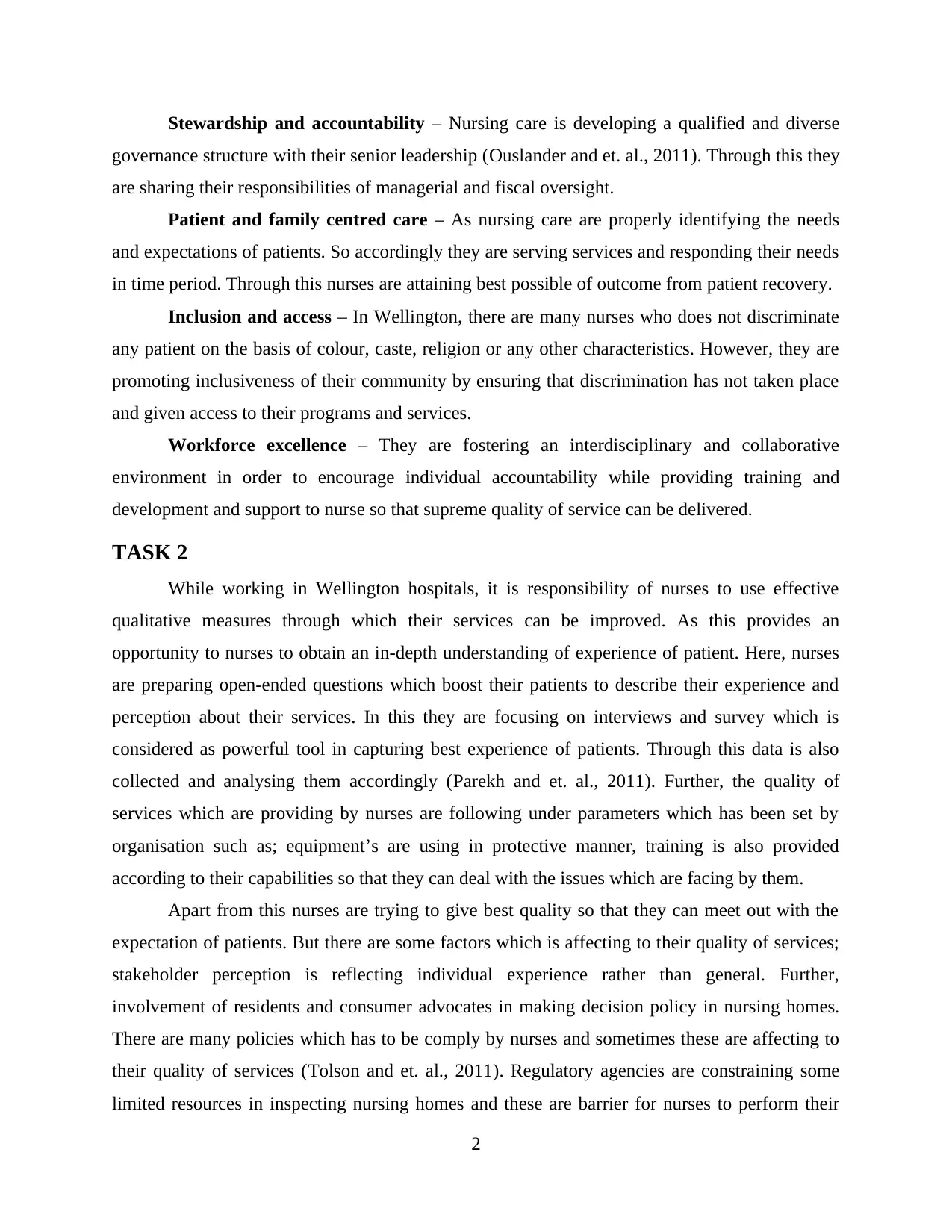
Stewardship and accountability – Nursing care is developing a qualified and diverse
governance structure with their senior leadership (Ouslander and et. al., 2011). Through this they
are sharing their responsibilities of managerial and fiscal oversight.
Patient and family centred care – As nursing care are properly identifying the needs
and expectations of patients. So accordingly they are serving services and responding their needs
in time period. Through this nurses are attaining best possible of outcome from patient recovery.
Inclusion and access – In Wellington, there are many nurses who does not discriminate
any patient on the basis of colour, caste, religion or any other characteristics. However, they are
promoting inclusiveness of their community by ensuring that discrimination has not taken place
and given access to their programs and services.
Workforce excellence – They are fostering an interdisciplinary and collaborative
environment in order to encourage individual accountability while providing training and
development and support to nurse so that supreme quality of service can be delivered.
TASK 2
While working in Wellington hospitals, it is responsibility of nurses to use effective
qualitative measures through which their services can be improved. As this provides an
opportunity to nurses to obtain an in-depth understanding of experience of patient. Here, nurses
are preparing open-ended questions which boost their patients to describe their experience and
perception about their services. In this they are focusing on interviews and survey which is
considered as powerful tool in capturing best experience of patients. Through this data is also
collected and analysing them accordingly (Parekh and et. al., 2011). Further, the quality of
services which are providing by nurses are following under parameters which has been set by
organisation such as; equipment’s are using in protective manner, training is also provided
according to their capabilities so that they can deal with the issues which are facing by them.
Apart from this nurses are trying to give best quality so that they can meet out with the
expectation of patients. But there are some factors which is affecting to their quality of services;
stakeholder perception is reflecting individual experience rather than general. Further,
involvement of residents and consumer advocates in making decision policy in nursing homes.
There are many policies which has to be comply by nurses and sometimes these are affecting to
their quality of services (Tolson and et. al., 2011). Regulatory agencies are constraining some
limited resources in inspecting nursing homes and these are barrier for nurses to perform their
2
governance structure with their senior leadership (Ouslander and et. al., 2011). Through this they
are sharing their responsibilities of managerial and fiscal oversight.
Patient and family centred care – As nursing care are properly identifying the needs
and expectations of patients. So accordingly they are serving services and responding their needs
in time period. Through this nurses are attaining best possible of outcome from patient recovery.
Inclusion and access – In Wellington, there are many nurses who does not discriminate
any patient on the basis of colour, caste, religion or any other characteristics. However, they are
promoting inclusiveness of their community by ensuring that discrimination has not taken place
and given access to their programs and services.
Workforce excellence – They are fostering an interdisciplinary and collaborative
environment in order to encourage individual accountability while providing training and
development and support to nurse so that supreme quality of service can be delivered.
TASK 2
While working in Wellington hospitals, it is responsibility of nurses to use effective
qualitative measures through which their services can be improved. As this provides an
opportunity to nurses to obtain an in-depth understanding of experience of patient. Here, nurses
are preparing open-ended questions which boost their patients to describe their experience and
perception about their services. In this they are focusing on interviews and survey which is
considered as powerful tool in capturing best experience of patients. Through this data is also
collected and analysing them accordingly (Parekh and et. al., 2011). Further, the quality of
services which are providing by nurses are following under parameters which has been set by
organisation such as; equipment’s are using in protective manner, training is also provided
according to their capabilities so that they can deal with the issues which are facing by them.
Apart from this nurses are trying to give best quality so that they can meet out with the
expectation of patients. But there are some factors which is affecting to their quality of services;
stakeholder perception is reflecting individual experience rather than general. Further,
involvement of residents and consumer advocates in making decision policy in nursing homes.
There are many policies which has to be comply by nurses and sometimes these are affecting to
their quality of services (Tolson and et. al., 2011). Regulatory agencies are constraining some
limited resources in inspecting nursing homes and these are barrier for nurses to perform their
2
Paraphrase This Document
Need a fresh take? Get an instant paraphrase of this document with our AI Paraphraser
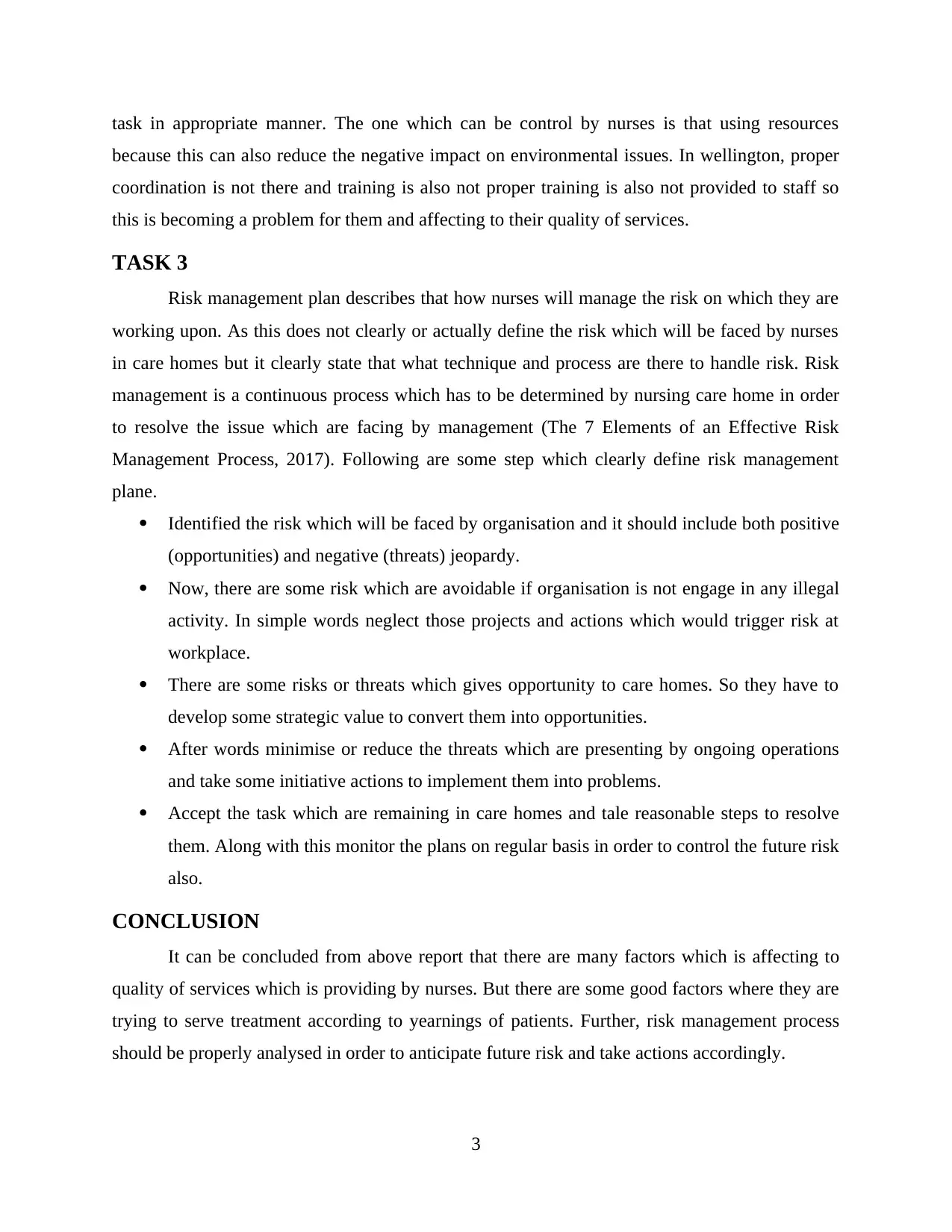
task in appropriate manner. The one which can be control by nurses is that using resources
because this can also reduce the negative impact on environmental issues. In wellington, proper
coordination is not there and training is also not proper training is also not provided to staff so
this is becoming a problem for them and affecting to their quality of services.
TASK 3
Risk management plan describes that how nurses will manage the risk on which they are
working upon. As this does not clearly or actually define the risk which will be faced by nurses
in care homes but it clearly state that what technique and process are there to handle risk. Risk
management is a continuous process which has to be determined by nursing care home in order
to resolve the issue which are facing by management (The 7 Elements of an Effective Risk
Management Process, 2017). Following are some step which clearly define risk management
plane.
Identified the risk which will be faced by organisation and it should include both positive
(opportunities) and negative (threats) jeopardy.
Now, there are some risk which are avoidable if organisation is not engage in any illegal
activity. In simple words neglect those projects and actions which would trigger risk at
workplace.
There are some risks or threats which gives opportunity to care homes. So they have to
develop some strategic value to convert them into opportunities.
After words minimise or reduce the threats which are presenting by ongoing operations
and take some initiative actions to implement them into problems.
Accept the task which are remaining in care homes and tale reasonable steps to resolve
them. Along with this monitor the plans on regular basis in order to control the future risk
also.
CONCLUSION
It can be concluded from above report that there are many factors which is affecting to
quality of services which is providing by nurses. But there are some good factors where they are
trying to serve treatment according to yearnings of patients. Further, risk management process
should be properly analysed in order to anticipate future risk and take actions accordingly.
3
because this can also reduce the negative impact on environmental issues. In wellington, proper
coordination is not there and training is also not proper training is also not provided to staff so
this is becoming a problem for them and affecting to their quality of services.
TASK 3
Risk management plan describes that how nurses will manage the risk on which they are
working upon. As this does not clearly or actually define the risk which will be faced by nurses
in care homes but it clearly state that what technique and process are there to handle risk. Risk
management is a continuous process which has to be determined by nursing care home in order
to resolve the issue which are facing by management (The 7 Elements of an Effective Risk
Management Process, 2017). Following are some step which clearly define risk management
plane.
Identified the risk which will be faced by organisation and it should include both positive
(opportunities) and negative (threats) jeopardy.
Now, there are some risk which are avoidable if organisation is not engage in any illegal
activity. In simple words neglect those projects and actions which would trigger risk at
workplace.
There are some risks or threats which gives opportunity to care homes. So they have to
develop some strategic value to convert them into opportunities.
After words minimise or reduce the threats which are presenting by ongoing operations
and take some initiative actions to implement them into problems.
Accept the task which are remaining in care homes and tale reasonable steps to resolve
them. Along with this monitor the plans on regular basis in order to control the future risk
also.
CONCLUSION
It can be concluded from above report that there are many factors which is affecting to
quality of services which is providing by nurses. But there are some good factors where they are
trying to serve treatment according to yearnings of patients. Further, risk management process
should be properly analysed in order to anticipate future risk and take actions accordingly.
3
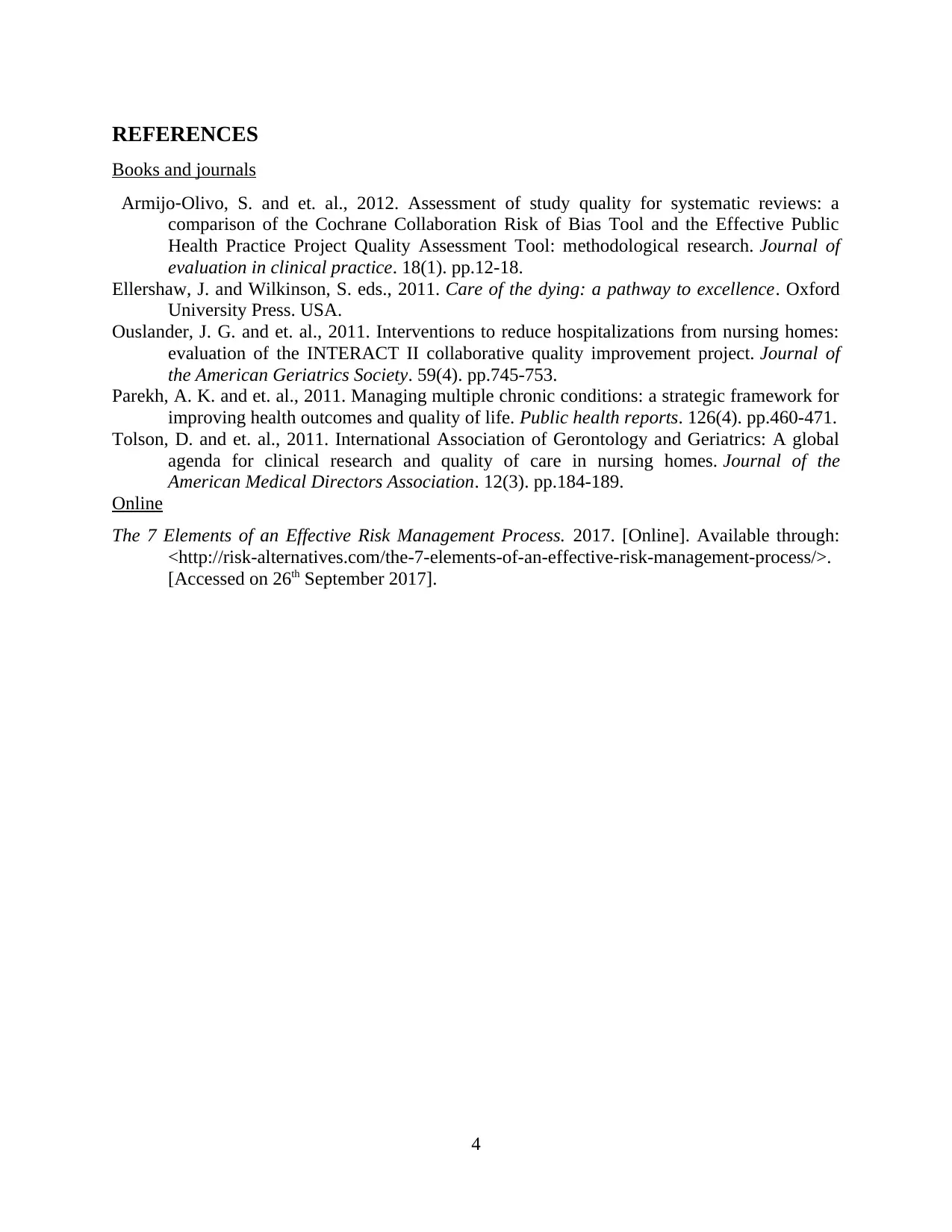
REFERENCES
Books and journals
Armijo‐Olivo, S. and et. al., 2012. Assessment of study quality for systematic reviews: a
comparison of the Cochrane Collaboration Risk of Bias Tool and the Effective Public
Health Practice Project Quality Assessment Tool: methodological research. Journal of
evaluation in clinical practice. 18(1). pp.12-18.
Ellershaw, J. and Wilkinson, S. eds., 2011. Care of the dying: a pathway to excellence. Oxford
University Press. USA.
Ouslander, J. G. and et. al., 2011. Interventions to reduce hospitalizations from nursing homes:
evaluation of the INTERACT II collaborative quality improvement project. Journal of
the American Geriatrics Society. 59(4). pp.745-753.
Parekh, A. K. and et. al., 2011. Managing multiple chronic conditions: a strategic framework for
improving health outcomes and quality of life. Public health reports. 126(4). pp.460-471.
Tolson, D. and et. al., 2011. International Association of Gerontology and Geriatrics: A global
agenda for clinical research and quality of care in nursing homes. Journal of the
American Medical Directors Association. 12(3). pp.184-189.
Online
The 7 Elements of an Effective Risk Management Process. 2017. [Online]. Available through:
<http://risk-alternatives.com/the-7-elements-of-an-effective-risk-management-process/>.
[Accessed on 26th September 2017].
4
Books and journals
Armijo‐Olivo, S. and et. al., 2012. Assessment of study quality for systematic reviews: a
comparison of the Cochrane Collaboration Risk of Bias Tool and the Effective Public
Health Practice Project Quality Assessment Tool: methodological research. Journal of
evaluation in clinical practice. 18(1). pp.12-18.
Ellershaw, J. and Wilkinson, S. eds., 2011. Care of the dying: a pathway to excellence. Oxford
University Press. USA.
Ouslander, J. G. and et. al., 2011. Interventions to reduce hospitalizations from nursing homes:
evaluation of the INTERACT II collaborative quality improvement project. Journal of
the American Geriatrics Society. 59(4). pp.745-753.
Parekh, A. K. and et. al., 2011. Managing multiple chronic conditions: a strategic framework for
improving health outcomes and quality of life. Public health reports. 126(4). pp.460-471.
Tolson, D. and et. al., 2011. International Association of Gerontology and Geriatrics: A global
agenda for clinical research and quality of care in nursing homes. Journal of the
American Medical Directors Association. 12(3). pp.184-189.
Online
The 7 Elements of an Effective Risk Management Process. 2017. [Online]. Available through:
<http://risk-alternatives.com/the-7-elements-of-an-effective-risk-management-process/>.
[Accessed on 26th September 2017].
4
⊘ This is a preview!⊘
Do you want full access?
Subscribe today to unlock all pages.

Trusted by 1+ million students worldwide
1 out of 6
Related Documents
Your All-in-One AI-Powered Toolkit for Academic Success.
+13062052269
info@desklib.com
Available 24*7 on WhatsApp / Email
![[object Object]](/_next/static/media/star-bottom.7253800d.svg)
Unlock your academic potential
Copyright © 2020–2025 A2Z Services. All Rights Reserved. Developed and managed by ZUCOL.





